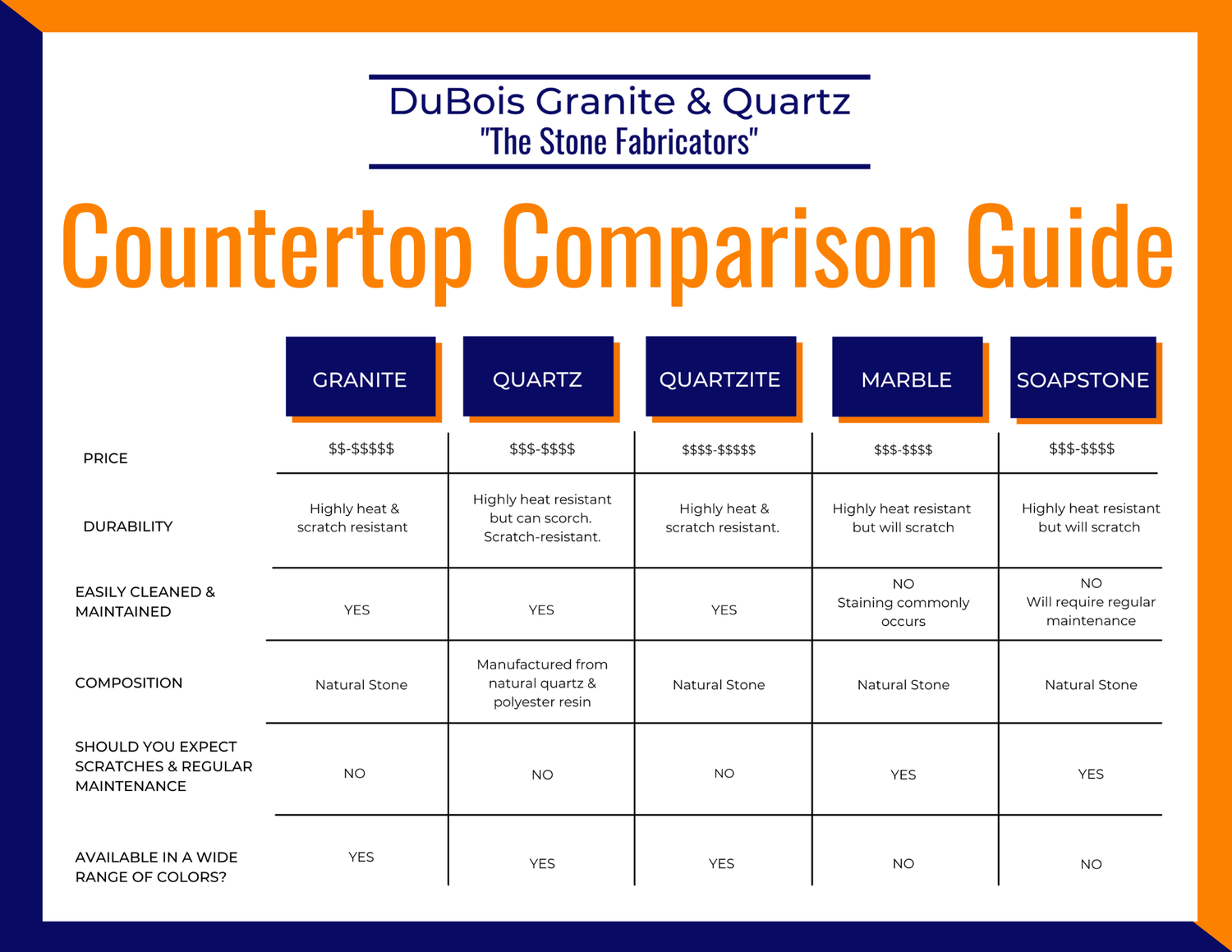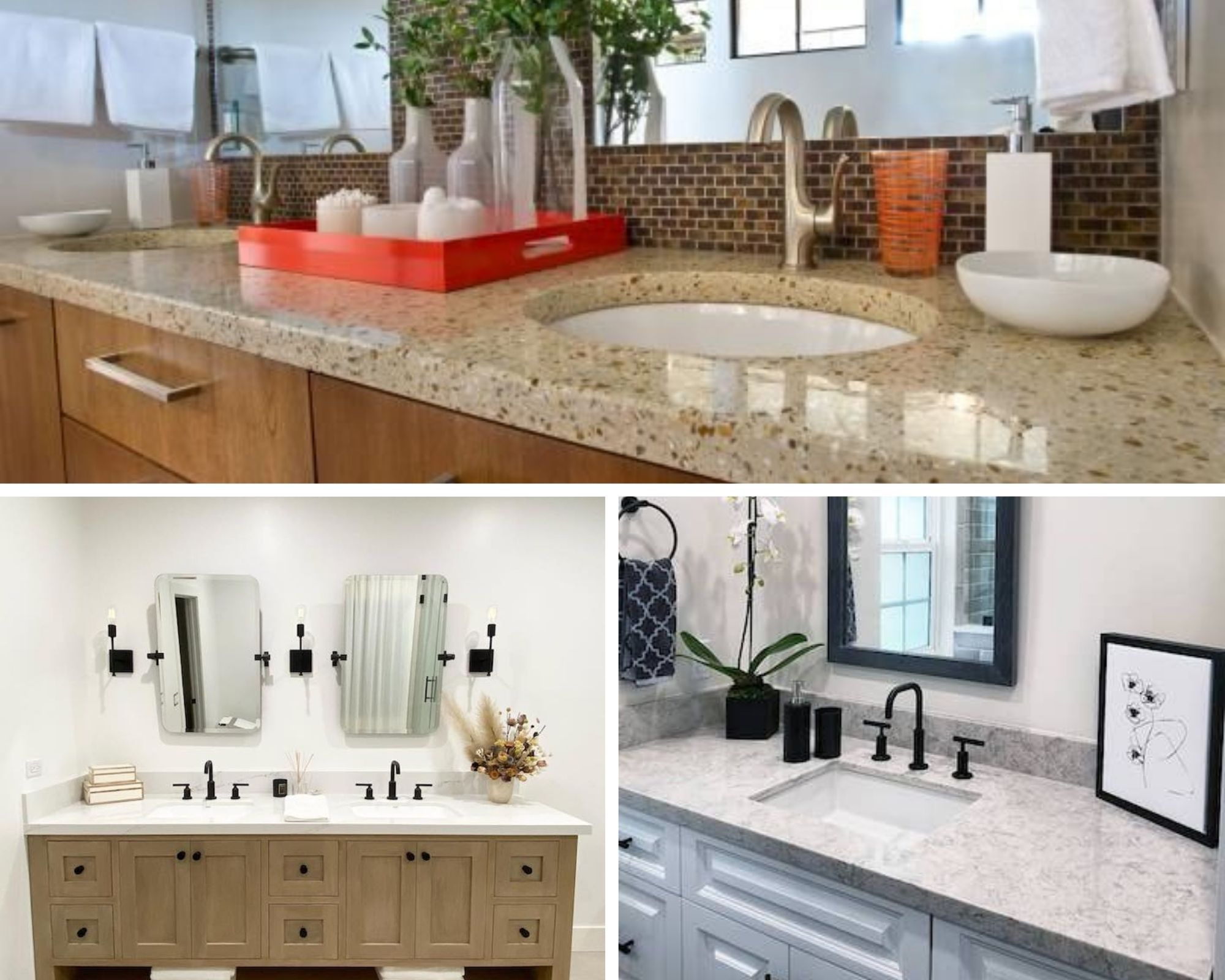Quartz vs. Granite: Quartz Vs Granite Bathroom Countertops

Choosing the right countertop material for your bathroom can be a daunting task, especially when considering the popular options of quartz and granite. Both offer unique advantages and disadvantages, making it essential to understand their characteristics to make an informed decision. This guide delves into the origins, properties, aesthetics, and common styles of quartz and granite countertops, providing a comprehensive comparison to help you navigate this material showdown.
Origins and Formation, Quartz vs granite bathroom countertops
Quartz and granite, both igneous rocks, are formed deep within the Earth’s crust through a complex process of heat, pressure, and crystallization. Quartz is primarily composed of silicon dioxide (SiO2), a mineral known for its hardness and durability. It forms as crystals within various igneous and metamorphic rocks. Granite, on the other hand, is a composite rock containing quartz, feldspar, mica, and other minerals. The unique combination of these minerals gives granite its distinctive speckled appearance and varying colors.
Physical Properties
The physical properties of quartz and granite play a crucial role in their suitability for countertops.
Hardness and Durability
Quartz countertops are known for their exceptional hardness and durability. They are typically manufactured using a blend of crushed quartz crystals and resin, resulting in a non-porous and highly resistant surface. This makes quartz countertops highly resistant to scratches, chips, and impacts.
Granite, being a natural stone, exhibits a natural variation in hardness. However, it is generally considered durable and resistant to scratches and chips. The Mohs hardness scale, which measures mineral hardness, rates quartz at 7 and granite at 6, indicating that quartz is slightly harder.
Heat Resistance
Both quartz and granite are relatively heat resistant, but they are not completely impervious to heat damage. While granite can withstand high temperatures, prolonged exposure to extreme heat, such as from hot pots or pans, can cause cracking or discoloration. Quartz countertops, due to the presence of resin, are more susceptible to heat damage and may warp or discolor under intense heat.
Stain Resistance
Quartz countertops are non-porous and therefore highly resistant to stains. The resin binder in quartz prevents liquids from penetrating the surface, making it ideal for areas prone to spills and stains.
Granite, being a porous stone, is more susceptible to staining. However, proper sealing can significantly reduce the risk of stains. Regular sealing helps to create a protective barrier on the surface, preventing liquids from penetrating the pores.
Aesthetic Qualities
Both quartz and granite offer a wide range of colors, patterns, and textures, allowing for customization and personalization of your bathroom design.
Patterns and Colors
Quartz countertops are available in a wide array of colors and patterns, including solid colors, speckled designs, and even those mimicking natural stone. The manufacturing process allows for precise control over color and pattern, offering a level of consistency and uniformity that natural stone cannot achieve.
Granite countertops, being a natural stone, exhibit a wide range of natural variations in color and pattern. From classic black and white to vibrant shades of red, green, and blue, granite offers a truly unique and authentic look. The natural patterns and variations in granite create a one-of-a-kind aesthetic that adds character and depth to any bathroom.
Textures
Quartz countertops typically feature a smooth, polished finish. However, some manufacturers offer textured finishes, such as honed or leathered, to create a more tactile experience.
Granite countertops are available in various finishes, including polished, honed, and flamed. Polished granite offers a high-gloss finish, while honed granite provides a matte, less reflective surface. Flamed granite, created by applying heat to the surface, creates a textured finish with a unique, rustic look.
Common Styles and Designs
Both quartz and granite countertops can be incorporated into various bathroom styles and designs, offering a versatile range of options to complement your personal taste.
Quartz Countertop Styles
Quartz countertops are often used in modern and contemporary bathroom designs, where their sleek and uniform appearance complements the minimalist aesthetic. Popular styles include:
* Solid Colors: White, gray, and black quartz countertops provide a clean and timeless backdrop for modern bathrooms.
* Speckled Designs: Quartz countertops with subtle speckles or flecks of color add visual interest and depth without overpowering the overall design.
* Calacatta Marble Look: Quartz countertops mimicking the luxurious veining of Calacatta marble offer a sophisticated and elegant touch.
Granite Countertop Styles
Granite countertops are a popular choice for traditional and rustic bathroom designs, where their natural beauty and variation add character and warmth. Common styles include:
* Black Granite: Black granite countertops provide a dramatic and sophisticated backdrop for traditional bathrooms.
* White Granite: White granite countertops offer a clean and classic look, complementing both traditional and contemporary styles.
* Multi-Colored Granite: Granite countertops with a mix of colors and patterns, such as those with red, green, or blue accents, add vibrancy and visual interest to the bathroom.
Performance and Maintenance

Choosing the right countertop material is crucial for any kitchen or bathroom remodel. While both quartz and granite are popular choices, they offer distinct advantages and disadvantages in terms of performance, maintenance, and environmental impact. This section delves into the practical aspects of using these materials in your home, comparing their durability, cleaning requirements, and long-term cost implications.
Daily Use and Maintenance
Quartz and granite countertops excel in different areas of everyday use. Quartz, being a manufactured material, boasts superior stain resistance and requires less maintenance. Its non-porous surface prevents liquids from penetrating, making it ideal for busy kitchens and bathrooms. Granite, on the other hand, is a natural stone with a porous surface. While it can be sealed to minimize absorption, spills and stains may require more attention.
- Quartz: Easy to clean with soap and water, resistant to scratches, heat, and stains. Requires minimal sealing.
- Granite: Requires regular sealing to prevent staining, prone to etching from acidic substances, susceptible to scratches and heat damage. Cleaning requires specific cleaners and techniques.
Cost Comparison
The initial cost of quartz countertops is generally higher than granite. However, the long-term maintenance costs for quartz are significantly lower due to its inherent durability and low maintenance requirements.
- Quartz: Higher initial cost, lower maintenance cost.
- Granite: Lower initial cost, higher maintenance cost (sealing, cleaning, potential repairs).
Environmental Impact
The environmental impact of quartz and granite production is a crucial factor to consider. Quartz production involves manufacturing processes that can contribute to air and water pollution. Granite mining, on the other hand, can have a significant impact on land use and biodiversity.
- Quartz: Manufacturing processes can generate air and water pollution, but some manufacturers use recycled materials and sustainable practices.
- Granite: Mining practices can lead to deforestation, habitat destruction, and soil erosion. Sustainable mining practices are essential to minimize environmental impact.
Choosing the Right Countertop Material
Ultimately, the best countertop material for your home depends on your individual lifestyle and preferences. Consider factors like your budget, cleaning habits, and desired aesthetic.
- Quartz: Ideal for busy households, those seeking low maintenance, and those prioritizing stain resistance.
- Granite: Suitable for those who enjoy the natural beauty of stone, are willing to invest in regular maintenance, and appreciate the unique patterns and colors offered by granite.
Design and Style

Quartz and granite countertops offer a wide array of design possibilities, allowing you to create a bathroom that reflects your unique style. Both materials come in a variety of colors, patterns, and finishes, providing endless options for personalization.
Quartz and Granite: A Comparison of Design Options
Quartz and granite offer a diverse range of colors, patterns, and finishes. Here’s a table comparing the design options for both materials:
| Feature | Quartz | Granite |
|---|---|---|
| Color Palette | Quartz comes in a wide spectrum of colors, from classic white and black to bold hues like red, blue, and green. It also features a variety of neutral tones, such as beige, gray, and brown. | Granite is known for its natural, earthy colors, ranging from warm browns and reds to cool grays and blacks. It also features unique veining patterns that add depth and character. |
| Veining Patterns | Quartz can be engineered to mimic the look of natural stone, with realistic veining patterns that range from subtle to dramatic. However, the veining is often more consistent and predictable than in granite. | Granite features naturally occurring veining patterns that are often more complex and varied than those found in quartz. The veining patterns can be subtle or bold, adding a unique touch to each slab. |
| Finishes | Quartz is available in a variety of finishes, including polished, honed, and leathered. Polished quartz offers a high-gloss shine, while honed quartz has a matte finish. Leathered quartz has a textured surface that is both elegant and durable. | Granite can be finished in a variety of ways, including polished, honed, and flamed. Polished granite offers a high-gloss shine, while honed granite has a matte finish. Flamed granite has a textured surface that is created by applying a flame to the stone. |
Quartz and Granite in Different Bathroom Styles
Quartz and granite countertops can complement a variety of bathroom styles. Here are some examples:
- Modern Bathroom: Quartz countertops in solid colors like white, gray, or black can create a sleek and minimalist look. Consider a quartz countertop with a subtle veining pattern for a touch of sophistication.
- Traditional Bathroom: Granite countertops with warm brown or beige tones can create a classic and elegant feel. Consider a granite countertop with a bold veining pattern for a touch of drama.
- Farmhouse Bathroom: Quartz countertops with a light, airy color palette, such as white or cream, can complement the rustic charm of a farmhouse bathroom. Look for quartz with a subtle veining pattern or a textured finish to add visual interest.
- Contemporary Bathroom: Quartz countertops in bold colors, such as blue, green, or red, can create a dramatic and modern look. Consider a quartz countertop with a unique veining pattern for a touch of personality.
Choosing the Right Countertop Color and Pattern
When choosing a countertop color and pattern, consider the following factors:
- Existing Bathroom Fixtures: Choose a countertop color that complements the color of your bathroom fixtures, such as the sink, faucet, and cabinet hardware.
- Bathroom Decor: Consider the overall style and color scheme of your bathroom when choosing a countertop. A countertop with a bold pattern can add a focal point to the room, while a countertop with a subtle pattern can blend seamlessly with the existing decor.
- Lighting: Lighting can affect how a countertop color appears. Consider the amount of natural light in your bathroom when choosing a countertop color. A light-colored countertop will reflect more light, while a dark-colored countertop will absorb more light.
